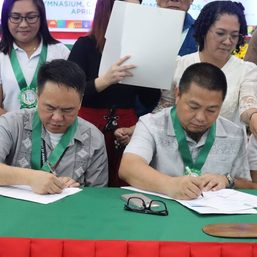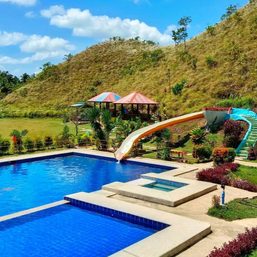SUMMARY
This is AI generated summarization, which may have errors. For context, always refer to the full article.

LAGUNA, Philippines – With the help of the cold Amyam (Amihan) winds wafting through the Libluban (the Kampapangan term for rice field), the Magdumans know the time is near for them to harvest their green-gold heirloom rice through their centuries-old practice of Pamagduman.
This tradition is what the local government, the Department of Tourism (DOT) for Central Luzon, and local researchers are trying to safeguard by nominating the Pamagduman to be a UNESCO-inscribed Intangible Cultural Heritage (ICH). Currently, the Philippines only has five protected ICH despite being a diverse multicultural and multiethnic nation.
Pamagduman is a unique method of cultivating glutinous rice in Pampanga – as well as some parts of Central Luzon – predominantly in Sta. Rita, Pampanga, through an intergenerational practice transferred within families. As written in its dossier, it “entails a long, segmented, and arduous reaping, sorting, threshing, cleaning, roasting, cooling, and winnowing that starts at dawn and lasts until midnight, depending on the yield.”
Renell Bucud, more fondly known as “Mang Galang,” took over as the head Magduman, or Mamuntuk in the local language, when the patriarch of the Galang family, Victor Galang, died in 2022.
Mang Galang, who married into the Galang clan, said that what’s interesting about the duman (the glutinous rice grain or finished product) is that you could only harvest it after the Amihan winds arrive, regardless of whether you planted your seeds in April, May, or even later in August.
The seasonality of this unique grain, coupled with intricate and laborious preparations, are only among the few factors why it is commonly priced at Php 4500 per salop (6 small cups).
Dr. Jonathan Niones, the Chief Science Research Specialist of the Philippine Rice Research Institute (PhilRice), answered through an email interview with Rappler that the Duman is among the traditional rice varieties (TRVs) of rice, specifically from the glutinous type called lakatan.
“I think the advantage of [the] Duman rice is [that it is among] glutinous and pigmented TRVs, which makes it more nutritious and healthier for the consumer. The added value of [having a] viviparous (pre-harvest sprouting) trait makes it different and unique from the other rice varieties,” Niones said.
Agriculture, family, and culture
Ruston Banal, the principal investigator, local champion, project convenor, and visual ethnographer/media specialist for the Duman, said that Pamagduman is the genesis of grassroots farming.
The way they use ethnoecological knowledge in cultivating Duman by allowing the cool northeast wind to let it bloom to its finest perfection and intervening at the perfect moment before it matures to produce the final product is what the locality and the researchers are trying to protect with their UNESCO-ICH element nomination. The right intervention in harvesting happens during the dawn when the wind is still cold and the sun has not yet hardened the grains.
After it is harvested from the libluban, the Magdumans bring it to the palbibewan, which is the multi-purpose roof-covered open space in the house used for milling, sorting, threshing, roasting, pounding, winnowing, and selling of the Duman. It is also where the instruments for Duman processing, some of which are decades old, are set up from November to December.
Pamagduman also represents strong familial bonds and a sense of responsibility for family members. This heirloom tradition is passed down to families, each having their seeds as a prized family possession and a signifier of their identity. Since 2022, only two families, Galang and Cuenca, out of the original 5 clans have been continuing the Pamagduman in the entire Central Luzon. Both families are located in Santo Monica, a barangay in Sta. Rita, Pampanga.
“There’s an astronomical aspect to it…It’s unique, it’s beautiful, it’s artisanal…it’s cultural, it’s musical,” said the Pampanga Provincial Tourism Officer Randy Del Rosario, explaining the importance of the Pamagduman not just in their annual Duman festival but for their town. He also said that they wanted to bring back the tradition where people sing chants during the Babage or the music produced during the pounding of Duman.
Challenges affecting the Pamagduman
Several factors continue to hinder the Pamagduman tradition, requiring safeguarding practices that they hope to get from becoming a UNESCO-inscribed ICH element. The depreciating number of clans harvesting Dumans is proof that the strenuous effort of sustaining this heritage is not economically satisfying.
With TRVs as naturally low-yielding and due to the Duman’s seasonality, the Magdumans can only produce a limited harvest. Most family members working on the farm up until its final product normally receive Php 500 for their 2 days of work, as most of the sales go to the expenses of preparing and ensuring the Duman’s growth.
“This is the irony of Duman. It is made by common farmers but they do not get to enjoy it or eat it,” Del Rosario mentioned, as these Magdumans would rather sell even a small amount of their products than consume it for themselves.
Unfortunately, most long-term consumers have also complained about the Duman quality, some of it losing its milky consistency. Niones told Rappler that there are various factors affecting its purity, including the lack of quality checks, exposure during seed growth, environmental factors, and many others.
“The Varietal Purity is very critical in the production of high-quality seeds (like Duman rice), satisfactory germination, and vigor. Maintaining true-to-type variety and seed quality produce of Duman rice will be sustainable throughout the generation of planting,” Dr. Niones clarified.
While the air is still fragrant during the harvest season and the Pamagduman process, older family members mentioned the current Duman is not as aromatic as it was before.
While there is no specific research for the Duman rice yet, Niones believes that PhilRice’s technical assistance and seed quality production training to the community could help in bringing back the true-to-type and high quality of the Duman seed to the community. It also aims to increase production which could help families economically and bring back some of its lost traditions during the Pamagduman.
Although currently limited, research funding has been helpful in steering awareness and protection for the Pamagduman. Aside from the DOT Region III, The Nanay Foundation, a local NGO, has helped this initiative by providing the initial funding for the research.
Del Rosario said that their efforts to secure the Pamagduman as a UNESCO-inscribed ICH element would not only ensure the longevity of this cultural heritage but also break socio-economic barriers by making the Duman more affordable. Buying from the farmers and visiting the town during its Duman festival every first Saturday of December are among the things Filipinos could support their cause. – Rappler.com
Add a comment
How does this make you feel?










There are no comments yet. Add your comment to start the conversation.